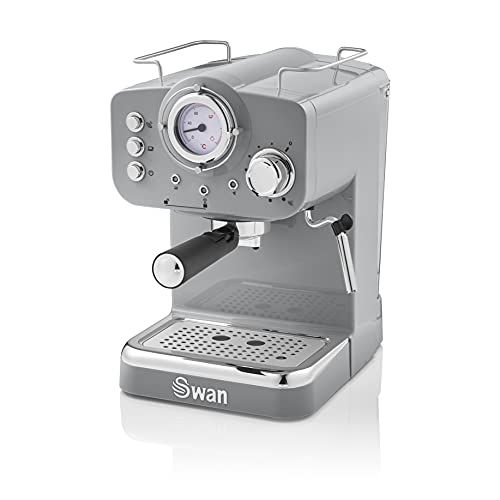How to Properly Maintain Coffee Espresso Machines
When you are looking for a coffee machine there are a few important factors to be considered. Depending on your preferences and budget, there are numerous options to choose from.
Espresso machines allow you to regulate key aspects like pressure and water temperature. Some even have dual boilers so that you can steam milk and brew coffee simultaneously.
Cost
The purchase of a coffee and espresso machine can be an investment of a significant amount but the ease of making your own delicious espresso and other special drinks will surely yield. You will not only save money, but you can also avoid the long lines at a cafe and reduce time and gas.
Espresso machines come in a variety shapes and sizes, depending on their degree of automation. The most basic models require the user to manually press down on the portafilter and tamp the ground beans while others feature an electric pump that can do much of the work for you. The most popular models come with a steam wand to heat and froth milk, as well with a large drip tray.
A pressure gauge on the front of the machine will indicate the operating pressure of the boiler as well as the pump. It is vital to check this regularly to ensure that the machine is operating properly.
Most espresso machines are compatible with coffee grounds as well as coffee pods. However, most people prefer fresh ground beans. Coffee pods, on the other hand, come pre-packaged. They might not permit you to determine the quality of your coffee. It's up to you, but it is important to remember that pods can become expensive over time if you choose to make use of coffee grounds instead.
Convenience
A espresso coffee maker can be used to make the majority of your espresso drinks. Depending on the model you select, it could also be used to make the latte art or other special drinks. Coffeee UK can save money by making use of an espresso machine instead of a coffee shop.
Espresso machines can be made with coffee grounds or pods. Grounds are more flavorful, offer more flexibility and require more work. You will need to measure and grind the beans by hand. Espresso machines based on pods are simple to use but do not provide the same flavor as espresso made from ground beans.
Consider a semi-automatic coffee machine that you can set to brew at specific times. This way, you can set the timer, and then leave to do other things while the machine is brewing your coffee. Think about a dual boiler system if you need to brew multiple cups at once. It has two separate boilers which are used to steam and brew.
Alternatively, you can opt for an espresso machine with a capsule that provides ultimate convenience. These use pre-packaged espresso capsules and have a water reservoir which you must fill. You can even find models that come with built-in milk frothers as well as a dishwasher-safe milk hopper that is removable and dishwasher-safe.
Quality
If properly used When used properly, an espresso machine will create coffee that is awash in flavor and aroma. The quality of the espresso depends on several factors including the size of the ground along with the temperature and amount of pressure applied to the ground. If the grind is not fine the water flows too quickly and the aroma can't be extracted. A coarse grind will result in a weak beverage that is bland or bitter.
Espresso machines use high pressure to force hot coffee water swiftly through finely ground and packed grounds of coffee. This results in the distinctive flavor of an espresso shot. This method can be utilized to make regular, less strong coffee that is just as delicious.
The size and quality of the portafilters that are used to brew steam and espresso is drawn into the cup also affect the quality an Espresso. It is crucial to select a portafilter that is well-made since it affects the consistency of the espresso as well as the steam.
Automatic espresso machines are programmable and can brew at the push of the button. They can make drinks in different sizes. Semi-automatic and manual espresso machines allow the operator to control different aspects of the brewing process, including when to cut the shot and the amount of pressure that is imposed on the ground. They generally require more maintenance, but can provide the highest quality in our Lab tests.
Maintenance

The cost and convenience of coffee espresso machines are attractive for a lot of businesses, but the quality and flavor of their products are contingent on the level of care they receive. A regular cleaning schedule for these tiny appliances will ensure they continue serve high-quality drinks and shots for many years.
The daily maintenance process begins by emptying the drip tray, which is where you can collect espresso and milk residue after each use. This can be done up to once a day, based on the model and how you use it. It is also necessary to clean the portafilter, group head and water screen on a regular basis. They are susceptible to grime accumulation that can cause low extraction and rancid taste in your coffee.
Every week, you should clean the steam tip, portafilter, and group head with a soft nylon toothbrush. It is also recommended to clean the gasket on the head and the buttons using a non-abrasive cleansing agent. Business owners should soak the items such as the drip tray and gratings for the night in accordance with the manufacturer's instructions.
Certain manufacturers recommend descaling their products on a monthly basis, however the frequency may vary based on the hardness of your water supply and how frequently you use your machine. You should fill the reservoir with the descaling solution according to the instructions given by the manufacturer.
